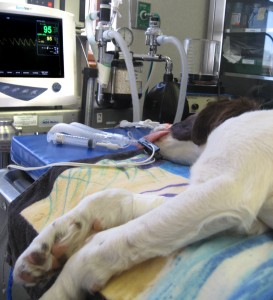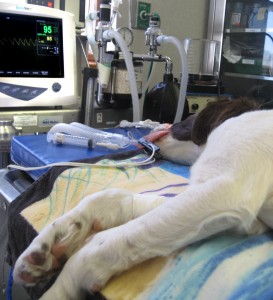 In my research, I found an incredibly helpful article written by Jessica Tremayne in Veterinary Practice News, which was published shortly after the AAHA released its anesthesia guidelines in November. A link to the full article is below, but I’ve excerpted a few interesting facts and quotes from the piece here:
In my research, I found an incredibly helpful article written by Jessica Tremayne in Veterinary Practice News, which was published shortly after the AAHA released its anesthesia guidelines in November. A link to the full article is below, but I’ve excerpted a few interesting facts and quotes from the piece here:
- 1 in every 1,000 pets who undergo anesthesia will die. That equates to one death every few years for the typical veterinarian.
- 1 in every 10,000 humans who undergo anesthesia will die. If the veterinary death rate were equivalent to the human death rate, the average vet may have one pet die from anesthesia during their entire career.
- Post-surgical monitoring is a critical component of safe anesthesia for pets. The majority of anesthesia-related pet deaths happen during the three hours after the surgical procedure, while the pet is in recovery.
- The AAHA anesthesia guidelines, while helpful, are only guidelines. Veterinary hospitals and clinics will not be required to meet the standards set forth in the guidelines for quality veterinary anesthesia care and monitoring to be certified by the AAHA.
“It has been interesting to me to see the general veterinary practitioner refer patients for (among others) complex surgical or cardiac procedures, and yet it seems that there is not a willingness to refer a patient who may require complex anesthetic management.”
“It is more common that someone would call an expert to ask for a plan that is ‘safe’ – the drug plan is sometimes the easiest part, it’s the other support and monitoring that often can make the difference and it may not available in the general practice environment.”
Khursheed Mama, DVM, Dipl. ACVA, professor and anesthesiology departmental representative for the anesthesia Section department of clinical sciences at Colorado State University in Fort Collins, Colorado
“The person in charge of monitoring the anesthetized patient needs to lay hands on the animal if the equipment is indicating there is a problem. Use a stethoscope – listen to the heart. Look at the patient’s mucous membranes. This is a job for a person capable of understanding how the machine obtained the reading and knowing what a correct reading should be.”
Peter Pascoe, DVM, Dipl. ACVA, professor (anesthesia), University of California, Davis, School of Veterinary Medicine
A link to the full Veterinary Practice News article can be found here:
http://www.veterinarypracticenews.com/vet-dept/small-animal-dept/the-changing-world-of-veterinary-anesthesia-guidelines-and-monitoring.aspx
A link to the American Animal Hospital Association (AAHA) anesthesia guidelines can be found here:
https://www.aahanet.org/PublicDocuments/Anesthesia_Guidelines_for_Dogs_and_Cats.pdf
A link to the home page of the American College of Veterinary Anesthesiologists (ACVA), which includes a link to the ACVA anesthesia monitoring guidelines can be found here:
http://www.acva.org/




Thank you for the articles. I have a six month old yorkie that weighs 3 pounds. I am very worried about anesthesia for her, I am a nurse anesthetist so I know the risks. You have given me some good suggestions.
What a lovely message to receive! Thank you!
I haven’t had the time to keep my blog updated lately, but I’m glad the content that is within it is helpful to those looking for guidance, especially on issues like veterinary anesthesia. I hope your puppy is doing well! I would love to know how you proceeded with her care, as well as how she responded.
Thanks again!
This is very helpful information. Anesthesiologists and Anesthetists have gone through medical school, as well as undergone specialized training and can monitor a human patient or animal patient during the entire process. My cousin worked for years as an Anesthesiologist, and she explained that safety for a patient is always the top priority. Everything is done to make sure that a patient is administered the correct amount of anesthesia and monitored during the procedure. Thanks for sharing this post!
Pet owners are often very anxious about veterinary procedures that involve anesthesia. Anesthesia is a critical and necessary part of your pet’s surgical process, however, there are some risks involved that pet owners should take into consideration to help ensure the success of their pet’s surgery. But when you are giving anesthesia to your pet be sure there will be no side effect to them. Doing treatment at a good veterinarian will be much more effective to keep your pet healthy.
Thanks discussing anesthesia with animals and that it’s safe. My dog was diagnosed with a disease that needs an invasive operation. My dad suggested my dog may need a veterinary anesthesia machine and shared this article with me.
I hope the site was helpful and that your dog’s surgery was a success!